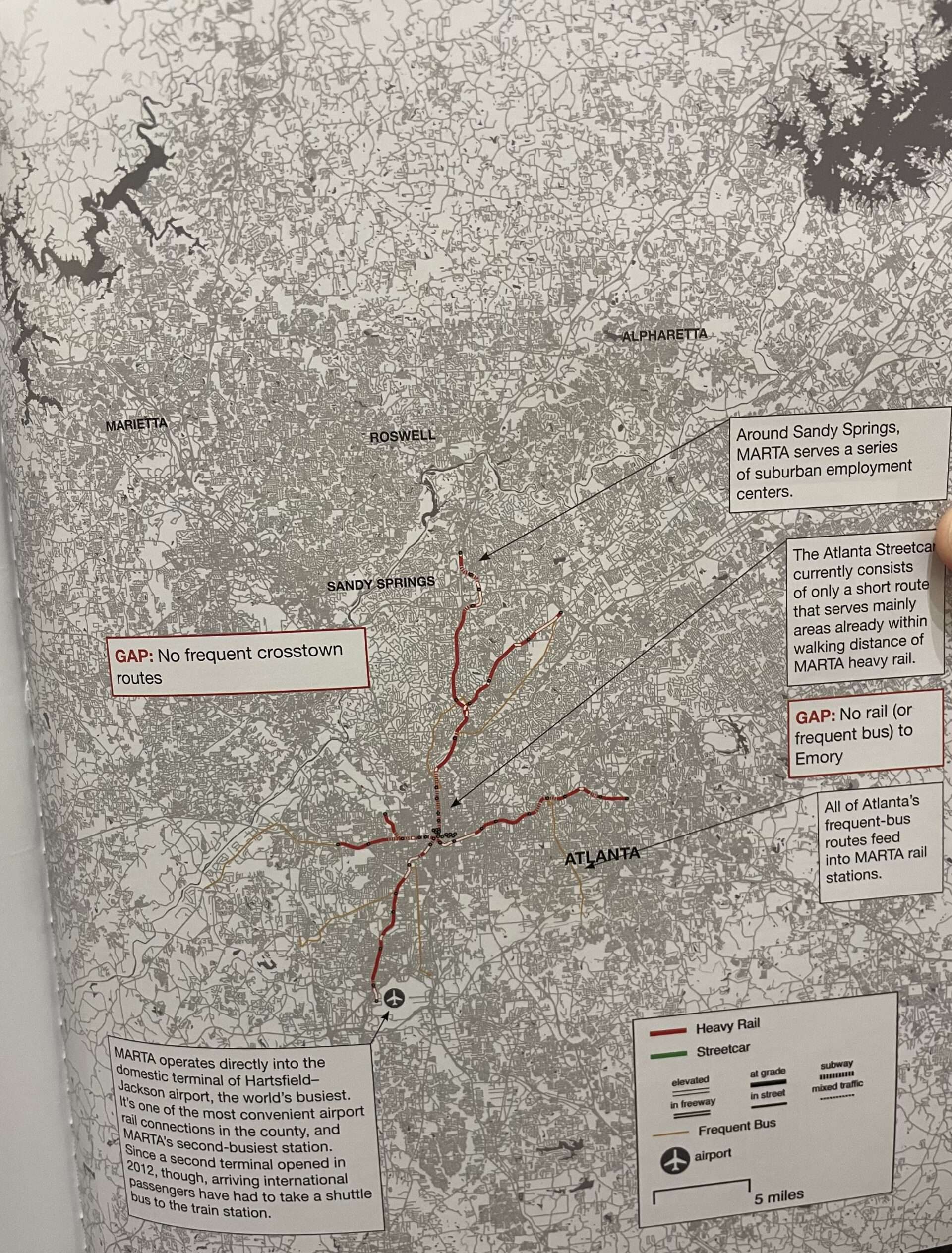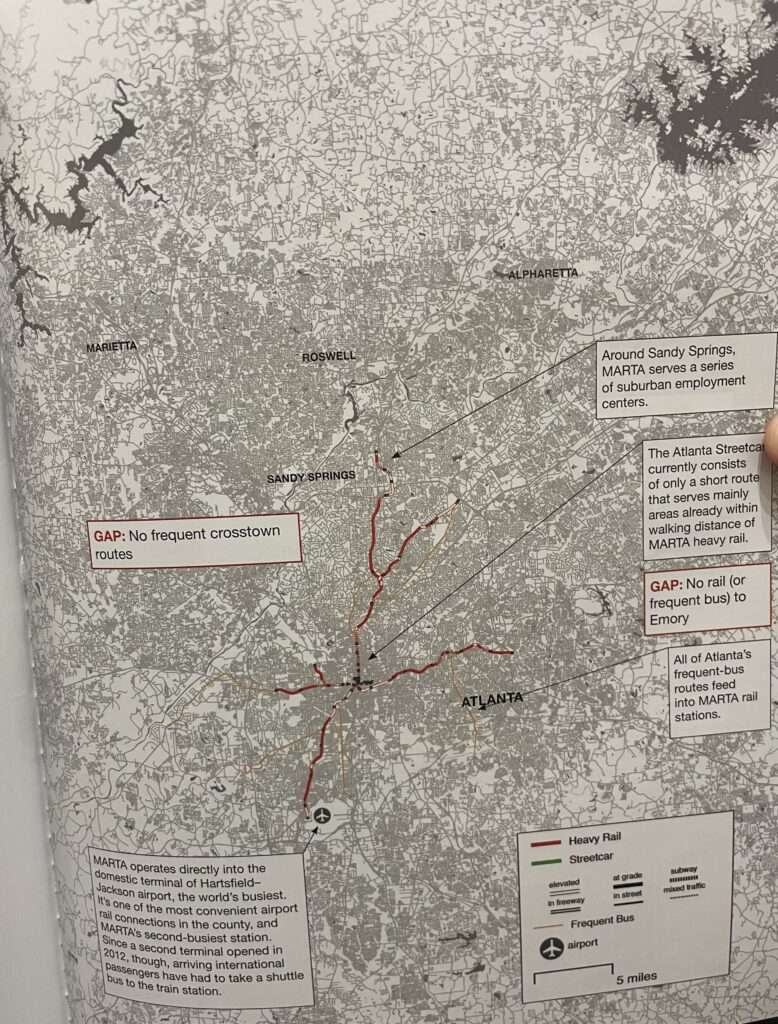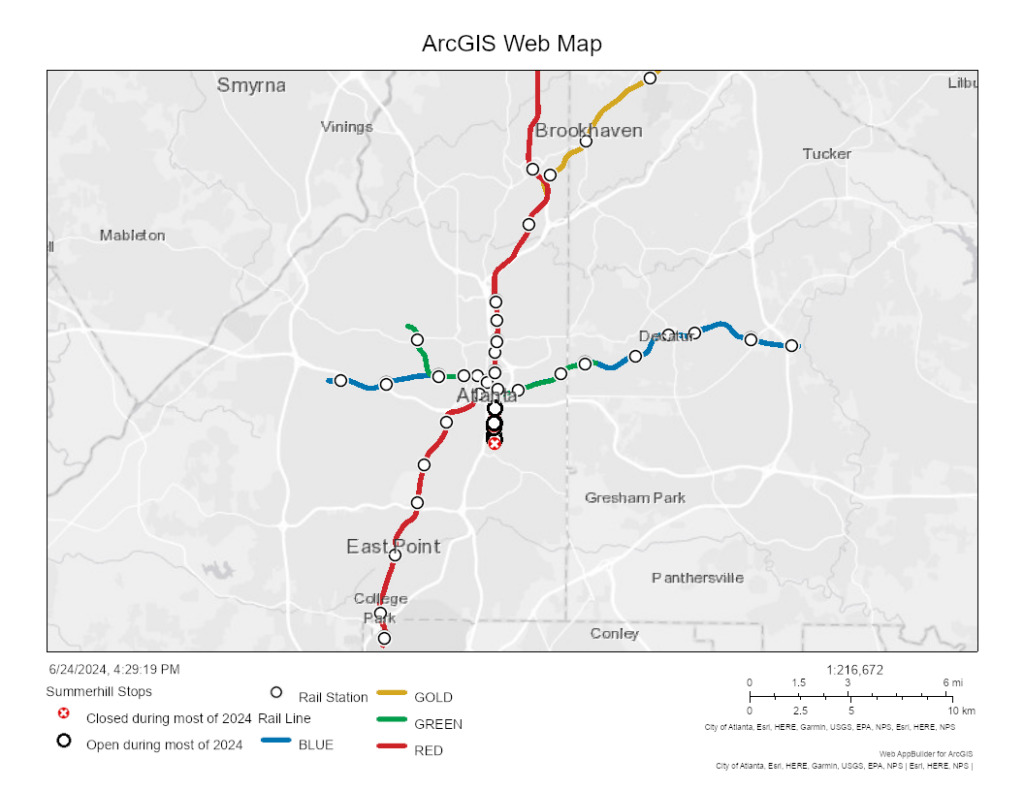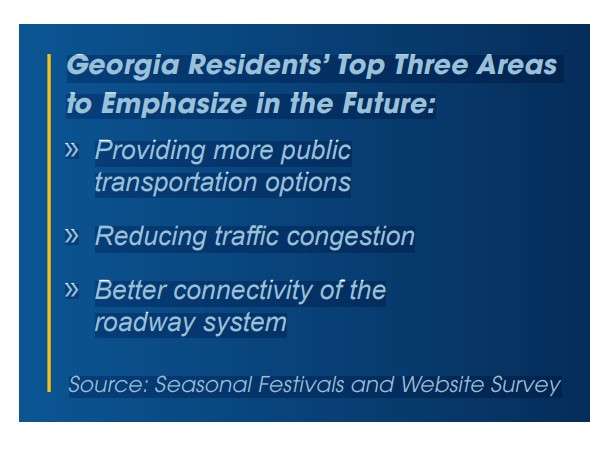
The Atlanta Way: How Transit Eats Our Own
Transportation is one of many ways that the Atlanta Way eats our own. We can’t seem to work together as one in this city. We have all these competing interests of drive-in commuters and tourists, residents who are unwilling to forego a little of their autonomy for the sake of a better transportation experience, and of course, there’s always the competing interests of the balkanized system of public-private partnerships and whatever entity one can find at the table. But we’re not unique, so what’s our challenge?
What I find in the echoes of The Atlanta Way is this perpetuation of a certain American ideal that’s straight out of the 60s- of suburban, car-centric, horizontally expanding, and low density. It’s a very R2 ideal that we find in Buckhead and Cascade, but it’s neither wanted nor feasible for the more modern business centers of Midtown streets. Combine that with the multi-modal system that comes together in Atlanta, it seems striking that I can use my Peach Pass in lieu of a Sun Pass in Florida or DoorDash here in the city, but I still can’t transfer back from CobbLinc to MARTA for a return trip for free any more than I can expect pizza to be delivered in rural areas of Georgia. I’m no economic nor transportation expert, yet it would seem that the easier we make it to move business and people, and the more options we provide as a state for the varied interests that show up here, the greater likelihood we’ll gain more tax digest and an eager workforce. Any way you look at it, I’d rather Georgians in business and personal life be able to move and live no matter where they live. As Senator Brandon Beach likes to say “We’ve got a great transportation system for 2.5 million people in metro Atlanta. Just five million people like to use it.” It’s actually now exceeding six million. Please look at the image below and tell me you can’t see the VAST opportunity before us.

We can’t discuss transportation in the U.S. Atlanta without discussing racism. While we may have moved from segregated sections of a bus, we aren’t ready yet to acknowledge our grandfathers’ and grandmothers’ willingness to pave over Black folks’ private property, divide the strongest Black neighborhoods in Atlanta, and how all of this contributes to why MARTA never expanded further west. That westside line is a whole lot shorter than the eastside line. Don’t believe the stylized maps on the train, here’s one to actual scale.

https://martaonline.maps.arcgis.com/apps/webappviewer/index.html?id=0ce5941618fe4cfe827155225d9640cc
You see, we can’t keep those elites separate from the workadays if we have integrated and accessible transportation across the city, now can we? That integration and emergence of social climbing really did lead to a whole Race Massacre, remember? Just like it did in several other cities.
Now fast forward to recent history, when Councilmember Norwood created a task force for a traffic study in Buckhead that is attempting to address the obscene traffic in Buckhead neighborhoods that have existed since I used those roads as a grad student and retail worker at Lenox Mall in 2007. I mean, no rush, y’all! Atlanta elites like our help to drive in, not live here with us. Now, if we wanted to question the process, we might ask ourselves why we require a traffic study for these roads when you could simply ask any of the 3,500 member Junior Leaguers or Speech School (Looking at you Tharon Johnson and Brian Robinson) or Pace Academy parents what their experience has been. But Imma put my money on the study expanding the contract with Via, the private, on-demand transit system company that provides the entire system for the City of Valdosta and also provides The Buc for Buckhead. I ain’t mad, I just don’t understand why my tax dollars have to go to both this AND MARTA at the same time when neither adequately serve my community. MARTA Reach was a great trial run, it’d be even greater if they went full-time with VIA, or at least learned how VIA is able to actually use their data for efficiency. To paint a clear picture, MARTA is a Louis DeJoy postal system and VIA is UPS.
Any of these multi-member orgs and businesses could tell you what we already know. But let’s go ahead, waste a few more months, maybe pay an outside third-party contractor or two (bonus if you’re paying off a brother or other family member), and then fight over it like a box full of pissed-off wolverines and bury it in committee. Throw a few pressers in for good measure-maybe the Mayor can leave again in a huff. Then in budget committee meetings, we can ask the other Buckhead Council member if he did enough drugs in high school to understand this math. (That was in regard to the last sanitation prices discussion, and will live forever rent-free in my head.)
Let me say I’d LOVE to see a BRT system that loops between 75 and the Buckhead Village. Essentially, the Village is largely pedestrianized during the holiday season, so why not make it year-round and connect MARTA, CobbLinc, and GRTA systems at Roxboro Rd. Or, if we’re feeling bold,extend it all the way up Peachtree to the Chamblee station? If you reduced part of the parking lot at Lenox, just think of how much tax revenue the City of Atlanta could generate. The Development Authority of Fulton County doesn’t even have to offer any abatements AND Arthur Ferdinand will still make that Kirby Smart money!
Governments like money, don’t they, dear reader? Pigs at the trough are an evil I’m willing to tolerate if it means we can efficiently move all the people who don’t live here.
And look, this isn’t Buckhead’s problem exclusively. We also haven’t ever extended MARTA further into the city’s West side, even though we’ve focused on recent development in Blandtown and had a little soccer event at the West End station (actually on the north/south line). These things are super cute, and hopefully, Soccer in the Streets makes MARTA more approachable to younger generations who will become regular riders as they age. Still, respectfully, this isn’t a serious approach to improving rider experience now or developing the city in a way that levels up our transit rather than paving another road. Even with the new infill stations the Mayor (not MARTA) has suggested, we’re not actually extending the rail; we’re just filling in at certain spots. And I believe the Mechanicsville station was the price of my Council member walking on the last Cop City vote. At least his neighborhood got something out of it, right? Hopefully, this will come to fruition in the next 20 years, albeit details about funding and whatnot remain fuzzy. Let’s just set a calendar reminder for 2044 and check back in then to see if these things come to be, shall we?
May we look a little wider in scope, pretty please?
I get asked to give car rides to kids in my neighborhood all the time. One might think this means I stick in the neighborhood. Nope! The other day FK asked if I could give a friend a ride from the friend’s dad’s house to the friend’s mom’s house. ‘Sure thing’, kid. I found out only when I arrived in Riverdale that I was picking up not only this friend, but the friend’s sister and the sister’s infant. I’m not mad- I understand this. My driving was a budget relief of at least a $30-$40 Uber ride in a suburb of our city where larger rental houses are affordable, and while bus transit is an option, it would have taken two and a quarter hours for the same ride that I provided in a half hour car ride. The bus was also not available in the Riverdale neighborhood, so this trip via transit would have required a walk, with no sidewalks, for a young mother, her infant in a carrier, and two overfilled bags on a June day.
The temperature as I was getting back onto the highway read 92 degrees. I’m all for ‘embrace the suck’ but that generally only applies when one is attempting betterment, not risking the health of an infant.
Now expand that to our teachers, LEOs, hospitality workers, and any other workaday who drives into the City of Atlanta. The fact of the matter is, if we don’t figure out how to move large groups of folks faster and with less friction (traffic, crashes, fatalities), we will be cutting our noses off to spite our faces in the pursuit of personal auto liberty while having to drive further and further to get meaningful wages to sustain life. This isn’t new and the age-old questions of ‘who is in charge around here?’ called me to do further research.
I took the time to read GDOT’s current (published in 2021 so one hopes to have an updated report shortly) Statewide Strategic Plan. I was hoping to read their Statewide Transportation Plan as well (they are labeled differently on GDOT’s website), but the links actually just lead to the same document. The plan has lots of pretty graphs and numbers, but the Governor’s goals are pretty ephemeral: “… to make Georgia #1 for small business, reform State government, strengthen rural Georgia, and put Georgians first.” I’m guessing some campaign flack in the Gov’s office set them. We all recognize that governance and campaign skills are two different skill sets, and unfortunately, Georgia and Atlanta seem to be run by a Governor and a Mayor who have great campaign skills but come up a little short in the governance department.

Blessedly, public opinion was captured, and (unsurprisingly) differs from the Governor’s goals and aligns more with what I’m talking about here:

While the GDOT Strategic Plan doesn’t offer many measurable goals, it seems fairly obvious that the connectivity MIGHT be missed because it isn’t represented in any real way in the report. I should add- when I use the term “connectivity” I mean intermodal(transportation-rail to roads, train to bus, etc.), whereas the term “connectivity” in the GDOT report seems to also refer to internet connectivity along fiber optic lines as part of the highway structure, particularly in rural areas. Both are important to business, I just want to acknowledge the narrowness of my language. Perhaps connectivity of both is in the practice, but the analysis in the report provided showed little evidence of that. Effectively, our railroads are owned by Norfolk Southern and CSX. Transit systems exist, but aren’t highlighted in any meaningful way in the report because they are locally or regionally operated. And if we want to improve any of these, GDOT isn’t really the entity to address. At the risk of being dismissive, the only thing GDOT seems to be in charge of is funneling money to CW Matthews to pave roads. We don’t really seem to have a convening entity to bring all of the stakeholders together. Well, we have The ATL, but the legislature tried to kill it last session. In essence, Georgians might have greater success in lobbying private companies for improved connectivity, as it seems that’s who has control of most of our assets.
And what about ADOT?
Well….I will remind you that ADOT was really just established by the poaching of workers from the Department of Public Works and rebranding it. Somewhere Ron Swanson is furious. So it isn’t surprising that the plan offered from ADOT is actually older than the state’s plan, and was completed in 2008…under Mayor Shirley Franklin. There was a 2015 update, focusing on transit…under Mayor Kasim Reed. So when I humbly ask, who do we advocate for change, I can’t direct you to just one entity- Georgia and Atlanta are both divided into so many little pockets of cronyism and petty squabbles it sort of boggles the mind. To borrow from Council Member Dustin Hillis, What has ADOT been doing for the last 9 years? So, while I remain constructively critical of my city of residence, I hope, dear reader, you understand it hasn’t a strong model within the state to follow. That does not preclude Mayor Dickens from his ability to follow other major city’s models. I presume that’s why our ADOT Commissioner was poached from the NY Transit Authority.
Here’s the thing: in a strong Mayor government, the buck starts and stops with our Mayor. And if the mayor couldn’t lead ants to a picnic, well, time to embrace the suck.
So if anyone wonders why I expect Mayor Dickens to have solutions for Atlanta’s challenges, it would be because this is how the strong the Mayor system is supposed to work. If the Mayor would like less heat, may I suggest/ interest him/ anyone in the City Manager approach or strong Council approach of city governing? IJS, it is clear after the last water crisis that the City Council isn’t going to hold Mayor Dickens accountable. I’m not sure why this Mayor gets the blank checks he gets from Council, but it is the rest of Atlanta’s loss. And if you think the water mess is over, I’d encourage you to look at the regular stream of mains that are reported as breaking daily. It’s unclear to me why the communications were such a mess, in a city that is the most surveilled in the nation and whose county has zero qualms about giving away tax abatements for $10 million in graphics cards for Elon Musk’s data centers, but here we are! I guess you can lead a horse to water, but you cannot force a city to openly communicate with its citizens, even when it watches our every move and has the data capacity to send every resident a text message, regardless of consent (I signed up for them. My husband definitely did not).
Recently, I had the lovely opportunity to visit coastal Georgia. While there, we took The Dot, Savannah’s Express Shuttle that loops around Forsyth Park back to our hotel area, off E. Bay. It was free, fast, air-conditioned, and, gosh, strikingly clean! The driver even spoke to us and told jokes along the way! It was like we were welcome in the city and appreciated as tourists! In contrast, my ride on the Streetcar named Debacle Atlanta Streetcar was cramped, I had no interaction with the driver, and it wasn’t particularly clean. The contrast between the two reminded me how behind Atlanta is in our public transit game. We have a streetcar, yes, but I would assert Savannah is an excellent example of how a city adjusts to a regular influx of folks who don’t live there.They’ve got a little something for everyone.
I used to think of Atlanta that way as well, but no longer. While my neighborhood rails about GDOT clear cutting trees & a lack of sound barrier along I-20, and Summerhill is trying to build out a sorta-kinda BRT system, a small yet vocal minority, not unlike the Alabama Cheerleader, is opposing Beltline rail (look, there’s Ann Cramer again- notice the pattern of how she shows up for businesses but not citizens?), even though (I kid you not) this was a part of the original idea of the Beltline. Like Cop City, the City of Atlanta makes plans for land use, then a small group of vocal folks cut their noses off to spite their faces by imagining a wholly different plan for the exact same area. We couldn’t stick to a plan if our lives depended upon it here! The hard truth of the matter is that The Atlanta Way empowers this small group of wealthy vocal folks from the north and eastern quadrants of the city to drown out those of us who would welcome transit (and may have chosen to move here to get to it). I don’t really understand this my-way-or-the-highway approach. Sandy Springs, Alpharetta, Smyrna, and Lawrenceville are lovely cities if you want the suburban feel-it seems so odd that these small groups of people who clearly might prefer to live elsewhere dictate how the rest of us live and concurrently don’t see how this is holding our city and state back from progress increasing density and scaling up.
If you think this small but vocal group is receding like the bygone era from which it came, I will direct you to the Saporta Report on the Atlanta Way 2.0 that was published today with Ann Cramer serving as the chair. Bless their hearts! I look forward to the day when older Atlantans step back from trying to sell the city to outsiders and investment groups and instead let the people who live and work here determine for ourselves what we wish to be. Dollars to donuts, it would not require branding or a cute name, but would include bringing people literally together in the sense of transit availability, to which Ms. Cramer has already stated her anti-Beltline rail stance. I personally cannot take this group seriously. They’re using old tricks to market Atlanta in the same way to the same elite business folks and are opposed to celebrating the uniqueness that is Atlanta.
Diversity of choice in cities in Georgia is our strength and Georgians spend our hard-earned money visiting other cities within our state due to that beautiful diversity. Dahlonega and Suches have gorgeous mountain roads. Savannah has her busy squares to linger and contemplate the day’s affairs. Macon’s tree-lined (and named) boulevards make it walkable and inviting. Athens’ pedestrianized spot in front of the Arch calls one to reflect on memories & future dreams, depending upon age. Cobb built an entire mini city around a baseball field to invite folks. They even stole The Roxy as the cherry on top! And yet neither Athens, nor Macon, nor Snob County has yet opened the gates of train travel to their cities.
Why not let Atlanta pioneer that path, then? Let us add another Gateway to the South! The rail spike doesn’t have to be limited to a gimmick at the Atlanta United matches! We don’t need to copy one another- we need to connect to one another! Want to improve our economy? Let’s improve the velocity of the money in Georgia. Give us the Brain Train, and connect all the Dawgs from Marietta, Cumming, even Athens and Columbus, via rail for Gameday without the worry of DUIs!
I was recently able to attend Ohio River South’s panel on transportation. I foolishly thought it was a legitimate exchange of ideas rather than the self-promotion of their own clients, but whatevs- I at least learned a few things. It was somewhat interesting to listen to ADOT Commissioner Solomon Caviness emphasize how he was from the “southside” of Atlanta without sharing with us where he lives now. A quick search of tax records in the county tells me his dad owns land in College Park, but Commissioner Caviness’ name doesn’t appear on any Fulton Co. tax records in that search (to be fair, the property could be in his spouse’s name, but it isn’t). I point this out not to pick on the man, but the last ADOT Commissioner, Josh Rowan (who I liked), lived in Smyrna. I always had a problem with that. Call me old-fashioned, but I think it matters if you live in the city that employs you. PARTICULARLY if you’re THE GUYin charge of directing how we address moving people and things. I’m a little tired of out-of-towners telling us how to do things and then driving home to their residences in the ‘burbs. Or, alternatively, OTP legislators and regular ‘ol citizens complaining about our traffic when they are the ones contributing to the challenge by only choosing to drive into our fair city for work or the latest concert. I’m over the out-of-towner infighting over Atlanta and I hope the Commissioner is as well. Perhaps Commissioner Caviness is taking transit daily to ensure he knows how his systems work from the bottom up. Here’s hoping he is willing to create an innovative Atlanta transportation plan!
And what about MARTA? I can’t leave out the elephant in the room. We all have so many questions, don’t we?
Where’s the money? The Mayor has jumped on the bandwagon of halting the Five Points Renovation project all while promoting infill stations with little to no info on where the funding is coming from or when this will happen. And really nary a peep about it since his press conference. We finally have an agreement that at least one entry/exit point will remain open (seriously, isn’t that a fire hazard)? As the hubs and I waited for our train the other night heading to the Symphony, I realized all of us in that station would be killed if something went wrong. Is this what Hell is supposed to be like? Forget Fire or Ice; the world ends in a busted MARTA station.
Then the Mayor AND MARTA have been fighting via effete public letters. Where are the adults?
Bueller?
Bueller?
Instead of us working together as a region, with workable Intergovernmental Agreements (IGAs) as other cities do (h/t to the Peach Pundit comment section educating me), we’ve got infighting with our major transit partner/adversary. It’s like there are too many cooks in the kitchen and we ‘re all forced to watch as the meal burns.
Now look, I firmly believe there isn’t a space that couldn’t benefit from an audit. From the Department of Defense to MARTA, let’s see where all the money is going. I also think the $230M canopy project is more window dressing than meaningful station maintenance. My challenge is, how are citizens who commute & use MARTA regularly benefiting from this? How is this contributing to an integrated system that works with Cobb’s and Gwinnett’s bus systems? Because until we get serious about getting commuters off the interstates and into mass transit, we aren’t really being serious at all. And the only way we get our business to grow, our people to prosper, and our state to rise to the top is for this all to gel, and move together rather than infighting.
What might this entail?
I’d start with a plan that includes more than separates out. And not some pretty powerpoint stuff, but you know, GDOT and ADOT reflecting the systems and how they work with one another and what each is doing regularly to reduce friction between each connecting point. Then maybe regular updates & renovations. A few years back, MARTA received money from the General Assembly to renovate the Bankhead station when Microsoft was supposed to be coming here. Then Microsoft bailed and fired something like 10,000 people. But can we please think of transportation in this state as a way to be helpful to our citizens, not just a selling point to invite others in? Look, I’m all for updating & renovating our stations! It’d be nice if the ceiling at Ashby didn’t leak every time the clouds thought about raining. I feel certain the responsible adults at the state are just accustomed to the ways the reports have been done in the past. But if we’re trying to attract more Fortune 500 companies to somewhere other than Atlanta, might we wish to make our systems and their ease of moving products and people more readily available, digestible, and transparent? I mean, we can absolutely be the special little snowflakes we all are and have uniquely designed plans, but wouldn’t it make more sense if our most populous city and our state put all of that together in a nice pretty package?
Then I’d move to ‘who are we serving?’ and ‘how can we improve?’.
I had the opportunity to attend a MARTA RAC dinner a while back. A couple of friends sit on the board, and one really wants me to serve despite it being VERY clear no one at MARTA wants that. LOL. We were unfortunately late to the dinner & ceremony, but not so much that I wasn’t present for the toast, offered by a MARTA Board member, also Propel’s (formerly known as the Atlanta Bike Coalition) Community Engagement Manager, and APAB’s current President. What struck me about the toast was that she encouraged everyone to stand for it- in a room that had quite a few folks who use wheelchairs. It clearly wasn’t purposefully callous, just a reminder that many Atlantans and Georgians continue to see transportation in our city through an ableist lens- even when their employer is agnostic about what form of transportation Atlantans’ choose.
Candidly, I was diagnosed with rheumatoid arthritis at age 15, so I’ve always known that my ability to move without pain will be shorter than some others. But I’m also aware that for even able-bodied individuals, the wide spacing between MARTA stations, the lack of available and working elevators, and escalators is just a pain! If we aren’t keeping equity in accessibility front of mind, then we are really lying to ourselves about serving everyone.
One *might* think our Dept. of City Planning would coordinate both with ADOT and GDOT to foster growth of transit modes in certain areas of development to meet the needs of the businesses and people moving there. Dare I say, we might plan our urban areas with the intention of serving the needs of the people rather than just business, but that logic seems to be wholly foreign in how we approach developments, tax abatements, urban planning, and transportation in this state. It’s as if the state of Georgia was an orchestra with each section playing from different sheet music. Perhaps the technical knowledge of the musicians is strong, but if the sound is nothing but cacophony, who would choose to stay and listen?
And this is part of what brings me to this series. We’re at a turning point in Georgia’s generational history, and we can either level up and overcome our past woes, or we can continue to brush them under the rug and fluff the old lace curtains before the World Cup guests come to town. You can roll that red carpet out to cover the pot holes, but you’re still gonna feel every last one as you roll over them.
Personally, I’m not interested in impressing them. I’m more interested in Georgia’s sustained success, which will be won by some basic budgeting for maintenance and will require some adults in the room rather than the egos I’m currently seeing. To borrow from C.J. Cregg, this isn’t sexy, but it’s good governance. It is what we are called to do.
If we want Georgia to live into its legacy as the Gateway to the South & Atlanta, the city ‘too busy to hate’, then we need to adjust how we talk, who we include in our planning, and how we approach the discussions with one another. I know the General Assembly members ran primaries on all this anti-’woke’ stuff, but the reality is, governing to invite in the world means we need to practice all those nice manners mamma taught us, treating everyone with respect, meeting them where we are, and striving to learn from those around us. I.E. Rule # 1, Don’t be a dick the Golden Rule.
Happily, this doesn’t require a high level of intelligence, but it does require a high level of humility. If there’s anything I’ve learned living in my neighborhood and being a foster parent, is how many edge cases of policies just fall through the cracks because no one thinks about them. This isn’t always even purposeful exclusion, it’s just that the abstraction of policy often means that the academic folks in the ivory towers aren’t well acquainted with the realities of how their well-intentioned ideas play out in application. So I would encourage state and local leaders to ask themselves who they are leaving out and what they have not yet thought of.
My questions I leave you with are:
- What are our steps to level up our transportation in the state? For our people, to invite business, tourism, and scale for growth? If we’re looking to connect more business, move more people, and improve quality of life, how should our current 20 year plan for these things be altered? We have publicly available short term plans (4 years). Is this still the right cadence of review?
- How do we move from the governing via press release trend to mutually supported governance in Atlanta? How would you suggest we work better with our regional partners?
- What are other cities in Georgia (or other states, countries) doing that we should be incorporating here? We just hosted royalty from the Netherlands- hopefully they taught our city leaders a few things about multi-modal transportation!
